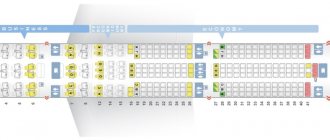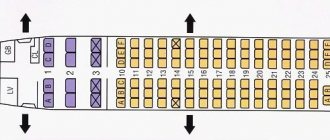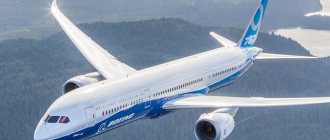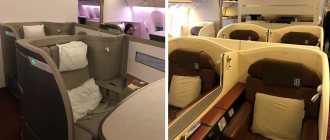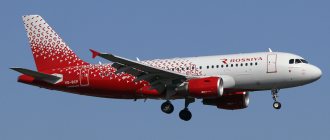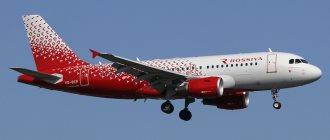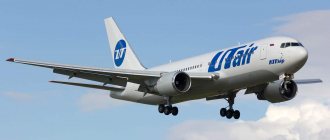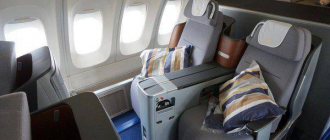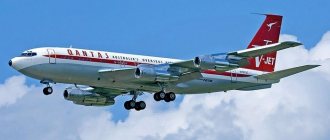The Boeing 747 is a passenger aircraft that until recently ranked first in the world in size (currently inferior to the Airbus A380). It has an upper and lower cabin, and the upper deck is much shorter than the lower one, due to which the silhouette is absolutely recognizable: it cannot be confused with any other aircraft. The aircraft is a long-haul aircraft.
Jumbo Jet holds the record for carrying passengers simultaneously. During the war in Ethiopia, on May 24, 1991, 1,122 Ethiopian Jews were evacuated in one plane flight to Israel, out of a design capacity of 480 people.
History of the development of the Boeing 747 passenger aircraft
In the mid-1960s, due to an increase in passenger traffic and the development of jet aviation, a demand arose for long-range aircraft with increased passenger capacity. At that time, the world was flying mainly first-generation jet aircraft, such as the Boeing 707, Tu-104 and others.
However, such aircraft could no longer cope with the load, and the first generation aircraft also had many design and other problems. As a result, Boeing decided to begin developing a new modification of airliners. In 1966, a car was presented to the public, completely different from its predecessors, with a hump on the roof. Initially, they wanted to make the plane double-decker, but due to the lack of experience in producing such aircraft, the look for which the 747 is famous was adopted.
Boeing 747 "Tigrolet" aircraft
In connection with the entry into the supersonic passenger aviation market, the corporation was quite skeptical about the aircraft. The removal of the cockpit to the upper deck was caused by the considerations that if suddenly the aircraft was not sold, it would quickly be converted into a cargo model, and for this, the cockpit should not interfere with the loading of cargo through the bow ramp, which will be in the truck.
It was believed that the maximum required was 400 aircraft of this type. However, at the moment more than one and a half thousand aircraft have been sold. If it were not for the direct competitor - the A380, the number of aircraft sold would have been even greater. Pratt & Whitney created a turbofan engine specifically for this aircraft - the JT9D. The wing mechanization, “advanced” for those times, was developed, which made it possible to use a heavy side from standard runways (runways).
State-owned US Air Force aircraft factories were widely used in the production of the Boeing 747. The law prohibits the involvement of state-owned factories to fulfill commercial orders of other companies. Let us leave this fact without comment.
Where are the bad places?
It's important to know where the worst places are so you don't accidentally buy a ticket for them. The plane of the Rossiya company has such seats, they spoil all the good impressions of the flight
In row 29, the backrests of the seats do not recline, as there is an emergency exit and a toilet nearby. Same problem in row 19. Seats A, D, E and L also cannot be folded out.
Worst places.
Those sitting on the seat under the letter C in rows 32, 33 and 34 will feel uncomfortable, as passengers will constantly walk past them. There are stairs nearby, along which people regularly walk up and down.
Travelers who bought tickets for rows 43, 54, 79 and 71 will be unhappy with the flight. There are emergency exits nearby, so the seats do not recline.
Important! Seats in lines 20 to 22, 27 to 29, 41 to 46 and 69 to 71 are located near the toilet. Here a queue of passengers forms, additional noise from their conversations and flushing of the tank.
On the second floor you should not buy a ticket for the last line. There is a toilet nearby, where passengers will constantly go, creating inconvenience for those sitting, there is also a staircase along which people go up and down while walking.
Description and technical characteristics
The aircraft is a four-engine turbofan low-wing aircraft with a swept wing and one fin (rudder).
Technical characteristics are given in the table:
| Characteristic | 747-100 (original version) | 747-400ER | 747-8 |
| Length | 70.6 m | 70.6 m | 76.3 m |
| Wingspan | 59.6 m | 64.4 m | 68.5 m |
| Fuselage width | 6.5 m | ||
| Height | 19.3 m | 19.4 m | 19.4 m |
| Wing area | 511 m² | 541 m² | 554 m² |
| Empty weight | 162.4 t | 180.8 t | 214.5 t |
| Cargo capacity | 170.6 m³ (5 pallets + 14 LD1s) | 158.6 m³ (4 pallets + 14 LD1s) | 275.6 m³ (8 pallets + 16 LD1s) |
| Capacity (number of passengers) | 366 (3 classes) 452 (2 classes) | 416 (3 classes) 524 (2 classes) | 467 (3 classes) 581 (2 classes) |
| Power point | 4 × Pratt & Whitney JT9D | 4 × General Electric CF6-80 | 4 × General Electric GEnx-2B67 |
| Engine thrust (4x) | 222.4 kN (22.6 t) | 281.1 kN (28.68 t) | 296.0 kN (30.2 t) |
| Crew | 3 | 2 | 2 |
The most interesting thing about this plane is that you can attach a fifth engine to it. This is used to transport a replacement engine to a remote airfield. The fifth engine is suspended at the root, that is, closer to the fuselage of the left wing. The engine is switched off during flight.
KLM Business Class
Best places
The article provides a typical layout of three classes on an air plane (Germany). The airliner has several first class seats - on the lower floor under the cockpits, 80 seats in business class and almost 300 seats in economy class. The total capacity of the Boeing 747-8 in this configuration is 386 seats.
There were no complaints about the first class - there is a lot of free space for passengers, they have the opportunity to sit comfortably, while each seat is located behind its own screen. Next are the front exits, refreshments and restrooms. The first row seats in business class, although spacious, are limited by a partition behind which there are toilets and a kitchen, which can create some inconvenience. Chairs 9C and 9H are located in close proximity to the aisle and restrooms. Passengers in rows 81 and 88 (second floor, first and last rows) can expect similar inconveniences. Passengers in the tenth row will have to look at the partition in front of them the entire flight, which, naturally, is quite uncomfortable. Business class seats 6 people in a row, with two aisles separating them.
Economy class starts from rows No. 16 and 18. The sixteenth row has only 6 seats. Considering that there are no passengers in front of them, there is enough free space for the occupants of this row and they do not risk finding themselves in the trap created by the reclined seat of the person sitting in front. The same applies to the middle section in the 18th row. The twentieth row is located next to the emergency exit - this explains the absence of portholes. Passengers in the middle section in this row do not have the opportunity to take a horizontal position, since there is a wall of toilets behind them. The 21st-22nd rows repeat the arrangement of rows No. 16-18, except that in the 21st row there are only four seats that are not separated from the rest. There is also enough legroom, the only drawback is that there are emergency exits nearby. The middle section, namely rows 32 and 33, has rear walls, so you won’t be able to relax and lie down. All row 34 seats have a partition in front of them, which can result in limited space. Rows 45-47 are at the back of the plane, so it can be crowded. The 49th row can be called the most unfortunate, since the shortcomings mentioned earlier are fully present in this sector.
Flight characteristics of the Boeing 747
| Characteristic | 747-100 (original version) | 747-400ER | 747-8 |
| Maximum take-off weight | 340.2 t | 412.8 t | 442.2 t |
| Maximum speed | M=0.84 | M=0.855 | M=0.855 |
| Cruising speed | 955 km/h | 988 km/h | 988 km/h |
| Range with maximum load | 9800 km | 14,205 km | 14,815 km |
| Fuel reserve | 183 380 l | 241 140 l | 242 470 l |
| Cabin width | 6.1 m | ||
General
The Boeing 747, produced by the American company Boeing, often referred to as the Jumbo Jet, or simply 747, is the world's first wide-body long-haul passenger airliner. The first flight took place on February 9, 1969. At the time of its inception, the Boeing 747 was the largest, heaviest and most spacious passenger airliner, remaining so for 37 years until the introduction of the A380, which first flew in 2005.
The Boeing 747 has a two-deck layout, with the upper deck being significantly shorter than the lower deck. The size and peculiar “hump” of the upper deck have made the Boeing 747 one of the most recognizable aircraft in the world, the hero of dozens of films and a symbol of civil aviation.
There are several different variants of the Boeing 747, most of which can fly long range. The record holder among the 747 is the Boeing of the Australian airline Qantas Airways, which made a non-stop flight from London to Sydney in 1989, thereby covering 18,000 km in 20 hours and 9 minutes, without having any passengers or cargo on board.
Until September 2010, 1,527 Boeing 747 models were ordered, and 1,418 aircraft were delivered.
- Type - passenger aircraft
- Developer - Boeing
- First flight - February 9, 1969
- Start of operation - 1970 (Pan Am, TWA)
- Status - in operation
- Main operators - Japan Airlines, British Airways, Korean Air, Cathay Pacific
- Years of production - 1969 - present. V.
- Units produced - 1419 (as of April 2010)
- Unit cost - 747-100 - $24 million (1967), 747-200 - $39 million (1976), 747-300 - $82 million (1982), 747-400 - $228-260 million (2007)
- Options - Boeing E-4, Boeing VC-25, Boeing YAL-1
Interior layout and seating arrangement
Boeing 747-300 cabin diagram
Business class cabin
If you want to experience something unprecedented and ride on the upper deck of a Boeing 747, you should definitely take business class. It will be in the bow of the “hump” (upper deck). In our country, only air transport passengers on Boeing 747-400 aircraft. Let's look at the configuration of passenger seats using this airline as an example. The first three rows of the upper deck are business lounge seats. These are the best places. Comfortable seats that almost convert into a bed, large entertainment system monitors, passenger kits, delicious food - everything is available to business class ticket holders.
Economy class cabin
The remaining part of the upper deck and the entire lower deck is the realm of economy class. The best seats in economy are considered to be the seats in the first row after the business class cabin, since there is only a thin partition between the cabins and there will be much more legroom than in the middle rows.
Very good seats in the first rows of the lower deck. There are two, not three, places nearby, which is also much more convenient. The airline also recommends front row seats. These are rows 20, 31, 44, 55. They are positioned as seats with increased legroom.
Traditionally, the bad places are near the toilets, where passengers will constantly pass by you. Often in these rows the seat back does not recline. This must be taken into account when choosing places to fly.
Aerodynamic design
When creating the Boeing 747, a classic aerodynamic design was used. The airliner is a four-engine low-wing aircraft with swept wings and a single-fin tail.
The low-wing design involves placing the wing at the bottom of the fuselage. The low-wing design has both pros and cons. For passenger airliners, placing the wing at the bottom provides more advantages than disadvantages.
Advantages and disadvantages of Boeing
The Boeing 747 is one of the best long-haul aircraft in the world. Although now it is actively stepping on its heels, and even overtaking Airbus, the 747 confidently holds its own. For example, cargo sides have very good load-carrying capacity. It is not for nothing that many aircraft are used in the cargo version. In the cargo version, it is very convenient to transport oversized cargo due to the wide fuselage.
In general, the Boeing 747 is a very durable and unpretentious machine, which is why it enjoys well-deserved love among many airlines around the world. Some experts call the Boeing 747 the safest type of aircraft (aircraft) based on the number of accidents.
Aircraft 73N
This name was given to the modification of the Boeing 737 “Next Generation” for.
In the layout of this airline, the best seats will be the first four rows, with increased comfort and class of service. As for the remaining rows, the most convenient will be row 16 near the emergency exit, which is also called Space+. To get to these places you need to pay extra.
In conclusion, we note that the choice of location is undoubtedly important for a tourist. For each model, the cabin has a different layout and you should take care of booking the most comfortable seats in advance.
Main Boeing 747 models
During production, Boeing has developed many models of this type of aircraft.
Boeing 747-100
The first type of Boeing 747 was the 747-100 modification. A total of 250 aircraft of this type were manufactured and sent to customers, taking into account the SP, SR and B variations. The last aircraft, the 747-100, entered service with the operator in 1986. The plane experienced the joy of flight for the first time in February 1969, and already on January 1, 1970, the first passengers took to the skies on the new plane. After finishing its passenger service, some aircraft were converted to freighter 747-100(SF).
Boeing 747-400F Airlines Airbridgecargo
Boeing 747-100SR
The Boeing 747-100SR (Short Range) was created for short-haul lines. Almost all the ships went to Japan. A total of 29 aircraft of this modification were produced. By reducing the volume of fuel tanks and, accordingly, the weight of the aircraft, it was possible to increase the number of people transported on one flight. In total, this modification could transport up to 550 people at a time. Oddly enough, Japan became the main customer of the aircraft. The ships were often used on domestic flights.
Boeing 747-100SP
Aircraft of this model (Special Performance - the best characteristics) began to be produced in 1976 in the wake of competition with McDonnel Douglas and Lockheed Corporation. A total of 45 aircraft were produced. The aircraft's fuselage was changed (shortened), the keel was enlarged, and the wings were changed. The plane could transport up to 220 people over a distance of up to 10,500 km. With a plan of 200 aircraft, the corporation received orders for only 45 aircraft.
Boeing 747-200
Deliveries began in 1971. The engines were modernized, which developed more power, which increased the flight range. The modification turned out to be so successful that on its basis three air command posts (air command posts) of the US Army and two “Air Force No. 1” were created for flights of American presidents.
The aircraft was supplied in three versions:
- 200V - passenger version;
- 200C - could carry either passengers or cargo;
- 200F(Frightener) - cargo;
- The 747-200M Combi allowed cargo and passengers to be accommodated simultaneously by installing quick-release bulkheads in the cabin.
Boeing 747-300
After an unsuccessful attempt to develop a three-engine model 747, the index 300 moved on to a new modification of the 1980 model. By increasing the upper deck, it became possible to transport an increased number of passengers. Like the 747-200, the 300 featured the 747-300M (combi) and 747-300SR (short-haul) variants. The aircraft had a flight range of 12,400 km.
Boeing 747-400
The most frequently purchased model by airlines is the 747-400. This model has added Winglets - vertical wingtips, which improve the efficiency of the aircraft. During the design of this modification, the cockpit was changed, which made it possible to control the aircraft with the help of two crew members, instead of three pilots previously. Also launched into series are the 747-400M (combi), 747-400F and 747-400SF (freight).
A variant of the 747-400ER was created - an aircraft with an increased flight range.
Boeing 747-8
The 747-8 variant is the third generation of Boeing 747 aircraft. Production begins at the beginning of 2010. The plane received an extended fuselage. According to calculations, this model provides 10% more space per passenger and 11% less fuel consumption. The wings have also been redesigned. Due to the better wing profile obtained due to the use of composite materials, redesigned winglets (wing tips), improved avionics, control systems, etc., the aircraft has improved economic performance. In total, 2 modifications were made - 747-8F Freighter and 747-8I Intercontinental (passenger version). Currently in the United States, two 747-8I aircraft are being reconstructed to transport the US President, replacing the two existing 747-400 presidential pool aircraft.
Inter-deck staircase Boeing 747-8I
Boeing 747 LCF Dreamlifter
Since the start of deliveries of the Boeing 787 aircraft, it became clear that parts of this aircraft, which were supplied by third-party contractors, must somehow be delivered to the assembly plant. Delivery of a set of wings from Japan by sea lasted 30 days.
To speed up the aircraft assembly process, in 2003 the Boeing Corporation announced the development of an air truck with increased cargo space. The 747 Large Cargo Freighter was developed for this purpose. Although the 747LCF began flying in mid-2016, the US Federal Aviation Administration issued an airworthiness certificate for the 747LCF on June 2, 2007.
By analogy with the Boeing 787 Dreamliner, the aircraft was named Dreamlifter. Upon receipt of the aircraft's airworthiness certificate, the 747LCF cargo flights were partially counted as test flights.
The plane, nicknamed the baby elephant (Jumbo is the name of the baby elephant from the Disney cartoon), has its own unique, recognizable face and some kind of romantic flair. I think that every passenger will be interested in flying on such an aircraft.
Layout
In order not to experience inconvenience during the trip, it is advisable to take the search seriously. In the lower tier of the aircraft, the developers have provided 470 seats, which the airline classifies as “Tourist” class. Affordable airfare prices apply here.
Airplane cabin layout
The standard seat configuration includes several variations, but the basic layout is 3:4:3. In the tail of the plane, the seats are arranged according to the 2:4:2 principle, and in the nose - 2:3:2. The most uncomfortable seats are in the back of the plane, due to the nearby bathroom. Such chairs are traditionally not in demand - after all, fellow travelers and queues constantly passing by are unlikely to add enthusiasm.
Conventional seats are installed in the middle block along the axis of the aircraft. In this sector you will be able to work peacefully and even sleep without being distracted by other travelers. But don’t forget that there is no porthole, so you won’t be able to enjoy the view from the window.
There are 3 blocks of bathrooms installed on the lower deck: in the rear part, between the 43rd and 44th lines and at 20–22 rows. In addition, catering units and dressing rooms are equipped between sectors 31–34 and 54–59. Armchairs next to technical buildings will not be a good choice. In addition, line 31 has a descent from the upper tier of the liner.
A small staircase connects the upper and lower decks of the liner
As for the upper deck, the first three rows are reserved for business class passengers, and seats from lines 5 to 9 are reserved for customers who purchase tickets at the “Advanced Economy” fare. The platform occupies the nose of the aircraft. Here the designers equipped two blocks of restrooms and a staircase to the common salon. This is what the overall layout of the Boeing 747 400 Jet looks like. The interior layout (“Russia”), which we present below, will tell the tourist the best option for choosing a seat.
Story
Development
The idea to develop the Boeing 747 arose during the rapid growth of air travel in the 60s. The Boeing 707, which dominated the US air travel market at the time, was already struggling to cope with the growing flow of passengers. Before this, the Boeing Corporation was already developing a large transport aircraft for the US Army, but then the corporation lost to the project. However, Boeing's most loyal buyer, Pan American, developed requirements for a giant passenger aircraft that was to be twice as large as the 707. In 1966, the corporation introduced the configuration of a new aircraft, designated "747". The original design was a completely double-deck aircraft, but some difficulties arose with this configuration, and the design was abandoned in favor of the “hump”. Of the first series of 100 aircraft, Pan Am ordered 25.
At that time, it was believed that such giants would soon be supplanted by supersonic aircraft. Therefore, the 747 was initially developed as a cargo-passenger aircraft. Over time, it was even planned to completely convert all aircraft into cargo aircraft. The cockpit was placed on the upper deck specifically to be able to convert the nose of the aircraft into a cargo ramp. It was assumed that the market did not need more than 400 aircraft of this type, however, despite criticism and fierce competition, the thousandth aircraft was built in 1993. Only in the first decade of the 21st century did sales of the 747 begin to fall.
The construction of the aircraft was associated with some difficulties: the Boeing plant did not have the capacity to produce such giant aircraft. To do this, a new plant was built in the small town of Everett in Washington state, which became home to a new family of aircraft.
Pratt & Whitney developed a huge high-bypass ratio turbofan engine, the JT9D, which was originally used exclusively on the 747. In order to increase the level of safety and flight performance of the aircraft, 4 backup hydraulic systems and slotted flaps were installed on the 747, which allowed the aircraft to be used on standard-length runways.
While testing the aircraft for airworthiness certification, Boeing developed an unusual training device known as the "Waddell Van" (named after 747 test pilot Jack Waddell), which consisted of a mock-up cockpit mounted on the roof of a truck. The simulator was designed to train pilots to taxi the aircraft from such a high cockpit position.
Boeing promised Pan Am to deliver the first aircraft by 1970 - that is, it was necessary to design, build, test and certify the aircraft in less than 4 years. The work proceeded very quickly, but the corporation's enormous costs for building a new plant and developing the aircraft brought Boeing to the brink of bankruptcy. However, the enormous profit from the sale of “747” covered all the corporation’s costs.
Exploitation
Initially, major airlines were somewhat skeptical about the new aircraft. At the same time, McDonnell-Douglas Corporation (later absorbed by Boeing) and Lockheed were developing three-engine wide-body aircraft much smaller than the 747. Many aircraft will not justify their worth on long-haul routes and will not be as economical as the three-engine McDonnell Douglas DC-10 and Lockheed L-1011 TriStar. In addition, there was doubt that, due to its size, the 747 may not fit airport infrastructure. The A380 currently faces similar problems.
Air carriers were concerned about the high (compared to three-engine aircraft) fuel consumption. Many airlines immediately announced their reluctance to purchase the Boeing 747 due to the threat of a sharp increase in ticket prices.
Air carriers' concerns were justified. The fuel crisis of the 1970s caused soaring oil prices and a decline in air travel. Airlines were faced with the problem of the unprofitability of the Boeing 747: due to high ticket prices, the planes were flying half empty. American Airlines installed pianos and bars instead of seats in order to attract passengers, but these measures were not enough. Subsequently, the company converted all the aircraft into cargo planes and then sold them. After some time, Continental Airlines did the same with its planes. The new McDonnell Douglas DC-10, Lockheed L-1011 TriStar, and later the Airbus A300 and Boeing 767 captured most of the wide-body aircraft market. With the release of new aircraft, many air carriers almost immediately abandoned the 747 in favor of them. Among them: Air Canada, Aer Lingus, SAS, TAP Portugal and Olympic Airways.
Many airlines continue to use the Boeing 747 on particularly busy routes. In Asia, the 747 is often used on medium and even short-haul routes, especially in Japan. “747” is still used on the longest transcontinental lines. The largest 747 fleet belongs to the Japanese national airline Japan Airlines - 73 aircraft. British Airways has the largest fleet of 747-400 modifications, including 57 aircraft.
Boeing 747 aircraft are also operated in Russia. Transaero airline has eleven aircraft (six B747-200, three B747-300 and two B747-400), AirBridgeCargo airline, part of the Volga-Dnepr group of companies, has nine cargo aircraft (two Boeing 747-200F, one B747- 300F and six 747-400ERF).
The future of "747"
After the creation of the 747-400 modification, many options for improving the aircraft were considered, but only the 747-8 project of 2005 was approved.
The 747-X program was launched in response to Airbus Corporation's European A3XX program. This project involved the creation of Boeing 747-500X and Boeing 747-600X aircraft with a capacity of up to 800 passengers. General Electric Corporation and Pratt & Whitney formed a joint venture to produce GP7200 engines specifically for the larger 747. However, most air carriers preferred the development of a fundamentally new aircraft to the modernization of the old one, and after several months the project was closed.
After the official launch of the A380 program in 2000, Boeing again took up the 747-X, but later abandoned it in favor of the Sonic Cruiser project, a subsonic passenger aircraft project. Then the project was mothballed and the development of the Boeing 787 (originally 7E7) began. However, some ideas developed during the 747-X project found application in the Boeing 747-400ER aircraft.
In early 2004, Boeing published plans for the 747 "Advanced" aircraft. This aircraft is a stretched Boeing 747-400. The new aircraft is planned to use completely new avionics - similar to the avionics of the Boeing 787. On November 14, 2005, Boeing announced the start of the project, and the aircraft was designated Boeing 747-8. Airlines ordered 109 aircraft (33 passenger, 76 cargo). Of the passenger carriers, Lufthansa (20 aircraft), Korean Air (5 aircraft) and the American Boeing Business Jet (8 aircraft) showed interest in the 747-8. 8 airlines are interested in cargo (here the 747 has no competition, the cargo A380 is present only on diagrams so far), including Dubai Aerospace Enterprise (15 aircraft), Nippon Cargo Airlines (14 aircraft), Cargolux (13 aircraft), as well as the Russian Volga-Dnepr (5 aircraft)
Meanwhile, the last passenger Boeing 747-400 was delivered to the customer (Taiwanese China Airlines) in April 2005, since then only cargo Jumbo jets have rolled out of Boeing hangars. The number of aircraft of this type in operation is gradually decreasing.
Military modifications and aircraft of heads of state
- VC-25A - aircraft for transporting the President of the United States. Two VC-25As were built in the late 1980s based on the Boeing 747-200 airframe. They wear special colors. Air traffic control issues them the code Air Force One - the plane carrying the president. Currently used by US Presidents for domestic and foreign travel (see article VC-25).
- E-4B Nightwatch known as NEACP (National Emergency Airborne Command Post), pronounced "Kneecap", and since 1994, also known as NAOC (National Airborne Operations Center) - airborne command posts for the President of the United States, US Secretary of Defense, other members of senior management in the event of the outbreak of a nuclear war and the destruction of ground control structures. Their colloquial name in the USA is “doomsday planes”. The first 3 E-4As were built based on the Boeing 747-200 airframe at the Boeing plant in 1974-1978. In 1979, a redesigned E-4B was built, and in 1980, all three E-4As were redesigned as E-4Bs. Currently on duty at bases (see article E-4).
- The aircraft is used to transport the Space Shuttle from alternate launch sites to the main launch site at Cape Canaveral. The shuttle is mounted on the top of the fuselage.
- High payload and large internal volumes made the 747 a permanent participant in various missile defense programs of the US Army. Now it is equipped with an experimental high-power chemical laser designed to destroy enemy ballistic missiles in the acceleration area.
Aircraft losses
As of September 2010, a total of 49 Boeing 747 aircraft have been lost to crashes and serious accidents. There have been 31 attempts to hijack a Boeing 747, with 25 people killed. A total of 3,732 people died in these incidents. The largest aviation accident in terms of the number of victims (not counting the terrorist attack of September 11, 2001) occurred in 1977 on the island of Tenerife at Los Rodeos airport. Two Boeing 747s collided on the runway, killing 583 people (see Los Rodeos Airport disaster and List of aviation accidents and disasters).
